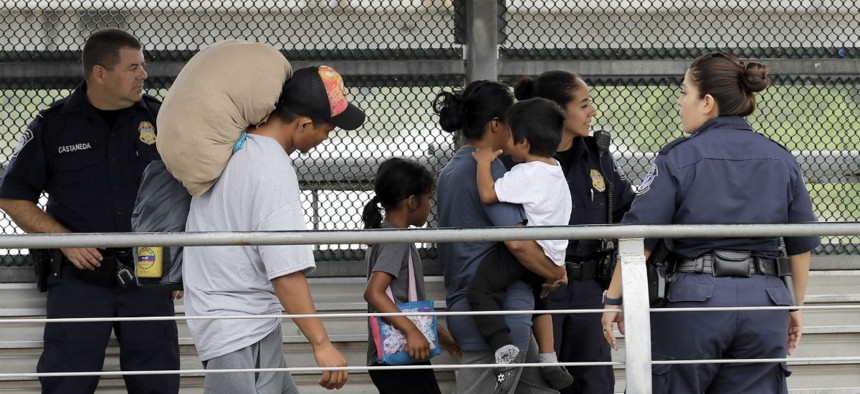Behind the Scenes of Implementing Trump's Border Hiring Surges
ICE employees have spent 2,000 work days preparing for a hiring surge that may never come.
The Trump administration has devoted significant manpower and financial resources to implementing the president’s immigration executive orders, according to a new report, despite the fact that Congress has declined to approve the new priorities as required.
At Immigration and Customs Enforcement, for example, agency employees in the human capital office have spent 14,000 hours preparing for Trump’s mandated hiring surge of 10,000 new agents, the Government Accountability Office found, though Congress has yet to provide funding or authority for the new personnel. That equates to 1,750 full work days. Agency workers have spent an additional 2,400 hours of overtime as they prepare for the theoretical hiring surge.
ICE prepared a contract solicitation for a private sector partner to help it hire the 10,000 agents and thousands of additional support staff, but ultimately canceled it due to lack of funding. The agency plans to reissue the contract next year.
The GAO report looked at three of President Trump’s early orders: one focusing on border security, another on interior enforcement of immigration laws and a third on the screening and vetting of visa and refugee applicants. The orders mobilized leaders at the departments of Homeland Security, Justice and State. They quickly established interagency working groups, task forces and metrics to track their progress.
DHS, which in addition to the ICE hiring surge was charged with bringing on 5,000 new Border Patrol agents, held weekly meetings and launched an online tracking system to monitor progress in implementing the orders. The department issued 90 and 180-day progress reports to the White House.
In some cases, tasks from the executive orders bled into ongoing agency responsibilities and GAO was therefore unable to discern exactly how much various offices had spent. The auditors did identify some costs specifically attributed to the executive order:
- $2.4 million: Justice’s spending to surge immigration judges at the southern border, as called for in the order.
- $4.2 million: U.S. Citizenship and Immigration Services’ spending to set up asylum detention centers at the border.
- $2.4 million: State’s spending on cancelling flights for refugees after Trump’s 120-day freeze went into place. The department saved a much more significant $160 million, however, by allowing fewer refugees into the country.
- $20 million: Customs and Border Protection’s reprogramming of funds toward planning and designing a new barrier along the southern border. Most of that was deferred from planned spending on a Mobile Video Surveillance System, while the rest came from a planned border fence replacement.
Additionally, in 2017, Congress provided DHS with $1.1 billion in supplemental funds to help it implement Trump’s orders. CBP spent $65 million on hiring, while ICE spent $150 million on ramping up its detention capacity.
Those two agencies have worked closely with the Office of Personnel Management to prepare for Trump’s hiring surge, in case Congress eventually authorizes it. They requested and received direct hire authority as well as a special salary rate for polygraphers. While ICE awaits hiring authorization and private sector assistance, it is continuing to work with OPM to streamline its hiring process. That will help the agency “ensure policies and procedures are in place to begin hiring additional personnel if funds are appropriated,” GAO said. CBP, meanwhile, has already awarded a hiring contract to Accenture—worth up to $297 million—to help the agency hire 7,500 agents and officers. ICE and CBP have begun hosting joint recruiting and hiring events to boost their rolls.
The orders required, in some cases, agencies to reverse course and implement entirely new procedures. In others, they could simply continue existing tasks to satisfy new demands. CBP, for example, simply continued its ongoing efforts to create a biometric entry-exit tracking system to meet Trump’s request. The Justice Department regularly sends immigration judges to the border, meeting another Trump mandate.
In a shift, ICE began reviewing previously closed cases to review whether they should remain closed under new deportation priorities. The agency also ceased its program of outreach to removable foreign nationals, using the savings to stand up the Victims of Immigration Crime Engagement (VOICE) office. ICE created 13 new border enforcement task forces, prioritizing investigations in El Salvador, Guatemala and Honduras. CBP prepared and awarded contracts for wall prototypes.
Despite the efforts the administration has taken to satisfy the president’s orders on hiring, it is losing ground. While CBP has seen a surge in applicants to fill the additional Border Patrol jobs the president has demanded, the agency is still losing more employees than it can bring on board. New deportation officer hiring at ICE dropped in half in Trump’s first year.




